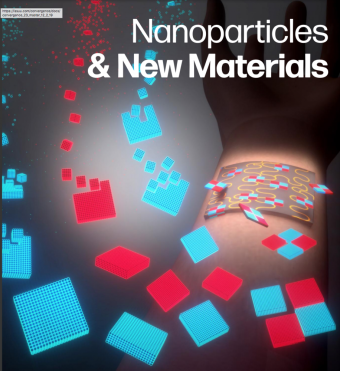
Materials made from nanoscale particles, which are less than 1 percent of the width of a human hair, create exciting opportunities to design new functional materials having unique responses to external stimuli, such as light, electrical and magnetic fields, and mechanical deformation. Embedding such particles in a "matrix" (here referring to a surrounding medium or structure) composed of a different material makes it possible to create nanocomposites that enable entirely new kinds of wearable sensors, highly efficient catalytic devices, and flexible displays.The central challenges in developing such transformative devices have recently been summarized in an insightful review article co-authored by two professors in UC Santa Barbara's College of Engineering – materials scientists Matthew Begley and Daniel Gianola – and their long -time collaborator Tyler Ray, a UCSB alumnus and professor at the University of Hawaii. This timely review, published in a recent issue of SCIENCE, describes the current state of the field, maps out future research directions, identifies challenges to progress, and highlights more than thirty projects that represent important directions and approaches going forward.
The review illustrates that a central need for tomorrow's materials scientists and engineers is to gain sufficient control during processing at multiple size scales to ensure that new materials not only have the necessary functional properties, but are also sufficiently robust to survive the stress of manufacturing techniques used to make macroscale devices. "In a nutshell, we' re interested in understanding, from a composite materials standpoint, how nano particles and the surrounding material can be integrated, not just to make interesting materials, but also to allow for patterning and integration of nanocomposites into actual commercially viable devices" Begley says.
"A key point is mechanical robustness," Ray adds . " If we're extruding a material and it is very fragile or cannot be patterned to connect to other materials effectively, it will likely not find its way into a device for widespread use."
Despite the challenges, Gianola notes that there is strong motivation for addressing these integration challenges, saying, "The ability to make interesting nanoscale particles has simply exploded over the past decade; nanocrystals having various shapes, sizes, and compositions have created an incredible materials 'palette' that can be used to design entirely new types of functionality."
This palette is just the first stage, because, ultimately, nanoparticles must be arranged in useful ways at larger length scales. The authors illustrate that the coupling between stimuli and response is strongly enhanced by having deterministic control of multiple length scales in a hierarchical structure, such as the ordering of crystalline nanoscale particles having a prescribed shape to form "superlattices"in materials exhibiting emergent collective behavior not hosted in the individual particles. As Begley puts it, "We need to pull nanocomposites out of the beaker and put them into actual devices."To do this requires researchers to connect the novel synthesis techniques that have enabled this materials palette to fabrication at larger length scales.
According to the review, the challenge of using ordered nanocomposites in applications stems from several related factors: " the limited availability of pathways for synthesizing and patterning such materials over length scales required for devices; the need to develop fabrication techniques that make it possible to integrate nanocomposites with other materials required to connect or protect functional components; and the limited understanding of the thermomechanical stability of nanocomposites, both as isolated materials and as embedded components."
The authors highlight the critical roles multiple types of research have in making progress, from scalable nanoparticle synthesis and self-assembly methods used to bind particles together in organized patterns, to acoustic assembly for organizing particle aggregates, and 3D printing of nanocomposites to facilitate patterning in actual devices. By integrating many different materials and perspectives on devices, the review provides keen insight into research that will lead to more widespread use of nanocomposites "Our hope is that by taking a holistic view of the field, we can help to identify sticking points in developing technology," says Gianola. "That, in turn, should allow us to more quickly identify material systems that exhibit both desirable properties and clear pathways to integration in devices. We are optimistic that the review will, at the very least, stimulate many interesting discussions among our colleagues, which is always the first step to inspiring advances."



